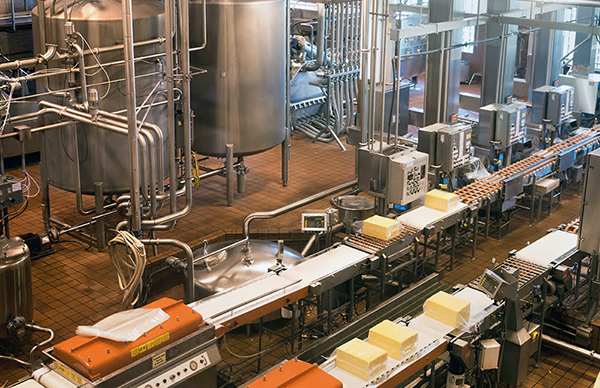During seasonal volume and demand peaks in the food and beverage industry, common practice is to increase labor and mobile equipment supplies temporarily. While this works great for small- to medium-sized businesses even in the current landscape, it’s not ideal for larger teams. This is primarily due to the evolution of technology, especially in the automation sector.
Adding more labor and machines can help increase volume, but it comes with a sizeable cost, one that could be shaved with the right process and system updates. As one might expect, adopting advanced automation systems, robotics and processes that can be controlled via machinery or software is the answer. Believe it or not, these systems can be made to work alongside and improve performance of existing laborers and teams.
In fact, automation is taking many industries by storm, and it’s about time food and beverage companies climbed aboard. Automotive, construction and healthcare are just three examples of industries already being disrupted by automation and AI.
But how is the technology being adopted or implemented in the food industry, and how will companies benefit from incorporating such systems?
Better Quality Control
Along the food and beverage supply chain, there are so many involved processes, workers and touchpoints that it can be difficult to not only keep track of food, but also to monitor its quality. As you know, quality is of incredible importance in the industry. You don’t want faulty or contaminated foods entering the market because it can be detrimental. Food must always remain traceable and safe, and it’s difficult to guarantee a system that has so many working cogs.
Automation, however, can change that completely. With the appropriate systems, defects and issues can be noticed much earlier in the supply chain. By detecting problems during packaging or processing, you can cut down on the total number of problematic goods that enter the market. Better yet, you can accurately identify when and where those problems are coming from and remedy the issue for improved performance in the future. If something along your supply chain is the culprit, automation will help you hone in.
Eliminating contamination can be controlled — and achieved — by deploying the appropriate cooling and air compressor systems. However, that also means understanding where this hardware must be utilized for maximum reliability. Automation and analytics systems can be helpful in discerning this information, better protecting foods and goods along the chain.
It’s not a pipe dream, either — systems are already being adopted and implemented to achieve such a thing.
End-To-End Traceability
While we touched on the idea of traceability a little in the point above, it’s the lion’s share that’s really going to make a difference. Automation and modern analytics tools can be deployed to track products and goods from inception to fulfillment. Because the systems in question are designed to track and monitor on their own with little to no input, you can tap in anywhere along the chain to seek the information you need.
Have a contaminated shipment that was discovered too late? You can use the modern analytics and automation tools at your disposal to find exactly where they are shipped or headed. This way you can head off a massive health problem before it even starts.
This, in turn, can help alleviate compliance costs and stressors, as well as improve the overall performance of the supply chain and various key processes. You could, for example, see how long a particular stop or touchpoint along the supply chain is taking and use the information provided to speed up performance.
End-to-end traceability and all the data that comes with it is about more than just watching where food comes from, where it is handled and where it goes. You can use the data provided to build an accurate profile and predictive system for future gains.
Improved Worker Safety
Automation systems, AI and modern robotics are often used to control rote, repetitive and sometimes even dangerous tasks. In this way, you can save human laborers from the dangers of a particular activity or even the monotony of busy work. It frees them up to handle more important demands, which is another benefit.
Of course, increased safety and protection for your loyal workforce can also work to alleviate operation or maintenance costs in the long run. It can lead to faster and more widespread adoption of new standards and regulations for your workforce at large as well. Traditionally, such a change might require additional training, new equipment or even better protection for your workers.
In the case of automation, you can simply update the existing hardware and software to be compliant and save the trouble of maintaining everything else, such as updating safety gear for your workers, which would no longer be necessary.
Efficiency Boost
It’s no secret that when deployed and developed properly, a machine or automation system can perform work faster and better than human laborers, at least in some cases. A machine never tires, never gets bored and can never slack off—unless it has a malfunction. That’s not to say modern technologies will be used to replace workers outright, but instead, they might be deployed alongside them to help them work faster, better and safer.
Take Amazon, for instance, which has deployed an army of AI and automation robots inside their warehouses to improve the efficiency of their order fulfillment process. It has the added benefit of speeding up the entire system, so customers get their items faster. It also improves safety and performance for the workers, effectively eliminating unsafe tasks or rote work.
Automation can provide benefits across the board for the food and beverage industry. It will be interesting to see how technological developments unfold.









Good article Megan. Blockchain is also becoming a very popular option for improving food safety, quality and traceability. But, to your point, what’s important is the data that’s collected and that the industry becomes proactive instead of reactive around these issues. Thanks!
Great content Megan! Automated processes can work 24/7 with occasional outages for maintenance, which is clearly faster than human operators can perform